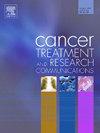Evaluating the tozzi classification system in diaphragm surgeries for advanced ovarian cancer: Clinical applicability and perioperative outcomes
IF 2.4
Q3 Medicine
引用次数: 0
Abstract
Background
Over 70 % of advanced ovarian cancer cases involve metastasis to the peritoneum, diaphragm, and liver. Standardised diaphragm surgeries are vital for achieving complete cytoreduction and enhancing patient prognosis.
Aim
This study evaluates the clinical utility of Tozzi’s classification for diaphragm surgeries and examines perioperative outcomes in advanced ovarian cancer debulking.
Methods
Patients who underwent diaphragm surgery during cytoreductive procedures for ovarian cancer were classified using Tozzi’s classification based on disease extent, and liver mobilisation and perioperative outcomes were analysed.
Results
Among 38 patients (71 % stage III; 52.6 % interval surgeries), 39.4 % were Type I, 28.9 % Type II, and 31.5 % Type III. Ascites was more common in Type II (77.8 %, p = 0.04), while Type III had more imaging-detected lesions (83.3 %, p = 0.03). Type III surgeries required longer durations (405 ± 136 min, p = 0.04) and more intraoperative interventions (58.3 %, p = 0.01). ICU care was needed in 50 % of cases, with a median stay of two days, mainly for Type III. Pulmonary complications occurred in 10.5 %, and the median hospital stay was six days.
Conclusion
Tozzi’s classification predicts surgical complexity and morbidity, particularly for Type III cases, aiding surgical planning and optimising patient outcomes.
评价tozzi分类系统在晚期卵巢癌横膈膜手术中的临床适用性和围手术期结果
背景:70%的晚期卵巢癌患者伴有腹膜、横膈膜和肝脏的转移。标准化的横膈膜手术对于实现完全的细胞减少和提高患者预后至关重要。目的本研究评估Tozzi分类在膈肌手术中的临床应用,并探讨晚期卵巢癌减积的围手术期预后。方法采用Tozzi分级法,根据疾病程度对卵巢癌行膈肌手术患者进行分类,分析患者肝脏活动情况及围手术期预后。结果38例患者中(71%为III期;52.6%为间歇手术),39.4%为ⅰ型,28.9%为ⅱ型,31.5%为ⅲ型。腹水在II型中更常见(77.8%,p = 0.04),而III型有更多的影像学检查病变(83.3%,p = 0.03)。III型手术时间较长(405±136 min, p = 0.04),术中干预较多(58.3%,p = 0.01)。50%的病例需要ICU护理,中位住院时间为2天,主要是III型。肺部并发症发生率为10.5%,中位住院时间为6天。结论tozzi分类预测手术复杂性和发病率,特别是III型病例,有助于手术计划和优化患者预后。
本文章由计算机程序翻译,如有差异,请以英文原文为准。
求助全文
约1分钟内获得全文
求助全文
来源期刊

Cancer treatment and research communications
Medicine-Oncology
CiteScore
4.30
自引率
0.00%
发文量
148
审稿时长
56 days
期刊介绍:
Cancer Treatment and Research Communications is an international peer-reviewed publication dedicated to providing comprehensive basic, translational, and clinical oncology research. The journal is devoted to articles on detection, diagnosis, prevention, policy, and treatment of cancer and provides a global forum for the nurturing and development of future generations of oncology scientists. Cancer Treatment and Research Communications publishes comprehensive reviews and original studies describing various aspects of basic through clinical research of all tumor types. The journal also accepts clinical studies in oncology, with an emphasis on prospective early phase clinical trials. Specific areas of interest include basic, translational, and clinical research and mechanistic approaches; cancer biology; molecular carcinogenesis; genetics and genomics; stem cell and developmental biology; immunology; molecular and cellular oncology; systems biology; drug sensitivity and resistance; gene and antisense therapy; pathology, markers, and prognostic indicators; chemoprevention strategies; multimodality therapy; cancer policy; and integration of various approaches. Our mission is to be the premier source of relevant information through promoting excellence in research and facilitating the timely translation of that science to health care and clinical practice.
 求助内容:
求助内容: 应助结果提醒方式:
应助结果提醒方式:


